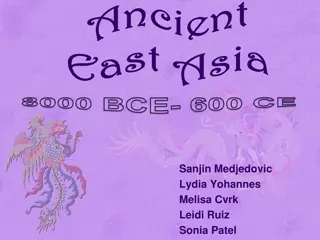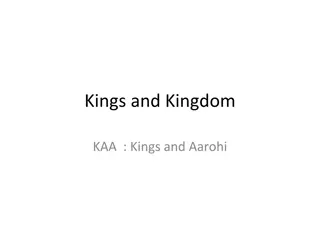Chinese Dynasties and Philosophies: From Han to Tang
Explore the rich history of Chinese dynasties from the Han to Tang periods, including the influence of Confucianism, Buddhism, and Daoism on society and governance. Witness the rise and fall of empires, cultural blending, and the societal values that shaped ancient China.
Uploaded on Oct 03, 2024 | 1 Views
Download Presentation

Please find below an Image/Link to download the presentation.
The content on the website is provided AS IS for your information and personal use only. It may not be sold, licensed, or shared on other websites without obtaining consent from the author.If you encounter any issues during the download, it is possible that the publisher has removed the file from their server.
You are allowed to download the files provided on this website for personal or commercial use, subject to the condition that they are used lawfully. All files are the property of their respective owners.
The content on the website is provided AS IS for your information and personal use only. It may not be sold, licensed, or shared on other websites without obtaining consent from the author.
E N D
Presentation Transcript
From Mrs. Oehlers Class Website Earl Warren Middle School, Solana Beach , CA
Han Dynasty Period of Disunion Sui Tang Dynasty Song Dynasty Yuan Dynasty Ming Dynasty Dynasty
Confucianism: Practical philosophy on life and government. Deals with 5 key relationships (ruler/subject; parent/child; husband/wife; sibling/sibling; friend/friend). Focused on traditions of respect and hard work. Buddhism: Arrives in China from India. Teaches that the world is essentially suffering. All people are on a path towards enlightenment (Nirvana). Essential part of achieving enlightenment is overcoming personal desires. Daoism: Believe that society prospers when people have harmony with nature Correct path (the Way or the Dao) is found in harmony between oneself and nature. Yin / Yang: opposing forces (light/dark; cold/heat; etc.)
Buddhism stressed military honor and Confucianism stresses charitable deeds Confucianism stresses ethical behavior and Buddhism stresses a spiritual outlook that promises escape from suffering (correct answer).. Buddhism teaches people to value public service while Confucianism teaches that personal satisfaction is most important. Confucianism places high value on artistic talents and Buddhism teaches one to ignore art. 1. 2. 3. 4.
After Han Dynasty collapses China splits into several rival kingdoms (Period of Disunion) Period of Disunion: New nomads settle in N. China Many N. Chinese move to S. China Cultural blending leads to new types of art, music, clothing, food, etc. Buddhism becomes popular belief liked Buddhism s teaching that people could escape/overcome suffering.
Sui Dynasty: Ended Period of Disunion Emperor Yang Jian Began the building of the Grand Canal to connect northern and southern China. Grand Canal connects major cities and major rivers leads to easier transportation (trade, cultural blending, spreading ideas/technology)
Tang Dynasty: Large scale growth of controlled land. Golden Age of China. Unified China by: military reform, law codes, land reform (equal field system). Included only woman to rule China (Empress Wu).
Song Dynasty: Reunified China again after brief period of chaos. Like Tang Dynasty, the Song Dynasty was a period of great accomplishment.
1. Only lasted a few years. 2. Was marked by great bloodshed. 3. Reunified China, ending a period of conflict between kingdoms (correct answer). 4. Was a period of few cultural accomplishments























